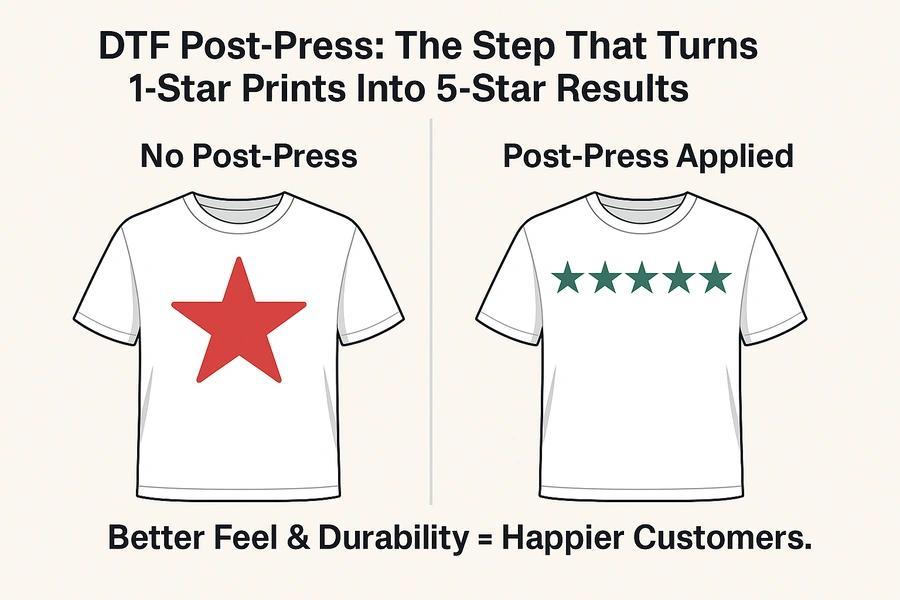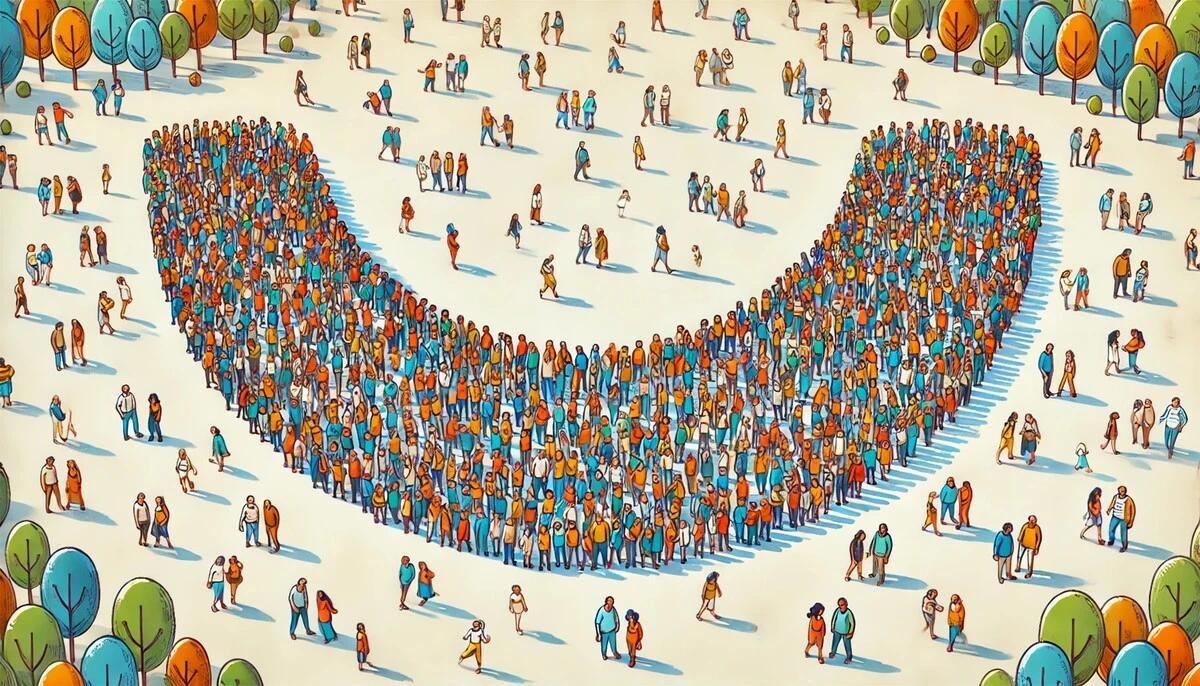DTF Post-Pressing: The Overlooked Step That Locks In Softness and Durability
Post-pressing is a critical step in the DTF workflow—especially when using short dwell times and low temperatures. This final press improves adhesion, completes the annealing process, and enhances the soft-touch feel your customers expect.

Page Content
Before You Continue...
Let’s be real. If you’ve skipped the pre‑press, you’re not using a reliable or verified heat press, and you’re not planning to post‑press, then you need to increase your main press time to compensate. That means 6 to 10 seconds—but never more than 12, or you risk damaging color and hand feel.
But if you did pre‑press, and you’re working with a calibrated, quality heat press, then technically, you can get by without a post‑press. That said…
We still highly recommend it.
Is it absolutely required? Maybe not in perfect conditions. But if you want peace of mind on adhesion and that extra edge in softness and durability—it’s a must.
Think of it this way: the post‑press isn’t just insurance—it’s the final polish. It completes the bond, helps the print wear better, and smooths the texture to give it that premium feel your customers will notice.
In our opinion?
Worth it. Every time.
Worth it. Every time.
What a DTF Post-Press Actually Does
Completes Adhesive Flow and Fiber Bonding
Thermoplastic polyurethane (TPU) adhesives used in DTF need to reach melt-flow and then cool in contact with the fabric to fully "wet out" the fibers. A short, low-temp press (like 3–5 seconds) gets this process started, but it doesn’t always allow time for:
- The adhesive to fully penetrate and wrap the fabric threads
- Small air pockets or micro gaps to collapse
- Uneven areas (like seams or texture) to settle
The post-press gives the TPU a second chance to reflow gently—solidifying uniform adhesion and reducing the risk of edge lift, peeling, or cold spots.
Finishes the Annealing Process
As TPU cools, its polymer chains begin to organize into a semi-crystalline structure—this process is called annealing. Proper annealing improves:
- Flexibility
- Wash resistance
- Long-term durability
When you press quickly and cool quickly, that structure may not fully form. A brief low-temp post-press adds thermal energy to help complete the polymer alignment—especially around complex areas of ink buildup or seams.
Softens and Levels the Print Surface
Immediately after pressing, some prints may feel gritty or slightly raised. This can come from powder buildup, thicker ink areas, or uneven surface contact during the main press. A post-press:
- Levels the ink and adhesive stack, reducing surface grain
- Compresses the film, improving hand feel
- Reduces edge graininess, especially on dark fabric prints
Use a Thermal Barrier: It’s Not Just About Texture
During the post‑press, we recommend placing a textured thermal barrier between the heat press platen and your print. The most common method? A clean, 100% cotton sheet—often cut from an old blank tee.
Why does this work?
- It spreads pressure more evenly, especially over raised areas or seams
- It reduces direct heat, giving a softer final finish without creating gloss or “heat box” marks
- It adds surface friction, which helps matte down graininess and leaves a subtle, tactile finish
You’ll see companies selling high-end texturizing top sheets or premium foils for this. Maybe they work—we haven’t tried them all. But in our experience, a cotton finishing cloth works just fine. No gimmicks, just physics.
How to Post‑Press for Best Results
- Temp: 280–290°F
- Time: 2–4 seconds
- Barrier: 100% cotton sheet or parchment-style finishing paper
- Pressure: Medium, enough for contact but not to crush soft fabrics
Optional: use lower pressure on lightweight garments to avoid embossing the surface.
When Post-Pressing Makes the Most Difference
Short dwell time (3–5s)
Completes adhesive melt and bondPerformance fabrics or soft blends, reduces gloss and improves flexibility
Heavy powder / thick ink prints
Flattens, levels, and softens the final print. We calibrate our prints to avoid this, but it's worth mentioning.
Retail-quality expectations
Enhances texture and color integrity after washing
Bottom Line
Post‑pressing isn’t a bonus—it’s the finish line. It improves adhesion, completes the thermal cycle, and elevates the feel of the print.
If you're aiming for top-tier quality—and especially if you're using fast, low-heat workflows like we recommend—this final step is how you make sure your prints last, feel great, and look pro.
Add it to your workflow. You won’t regret it.
Page Content
What People Are Saying
FIVE STARS!
"With Dmandprints, I’ve increased my business by over 30%, while saving both time and money. Their quality, service, and attention to detail have been outstanding—highly recommended!"

Essential Tips for Quality DTF Printing
Our guides are perfect for both beginners and seasoned print professionals. Discover valuable tips for creating artwork, mastering heat press techniques, and more. These resources ensure you achieve the best quality final product.
What Makes Dmandprints Different
Loading...
Popular Guides
Loading...
Creating Images for DTFs
Loading...
Feature Articles
Loading...
Q & A
Common Questions
Here are some quick questions and answers we frequently get about DTF prints and DMandPrints. We've placed them right here on the home page for your convenience!
Do you really think you have the best prints in the world?!
Do you really think you have the best prints in the world?!
Mmm... we think they’re pretty great—and we work relentlessly to keep making them better. It’s a bold claim (maybe even a little cocky), so we’ll let the results speak for themselves.
Do you sell printed garments?
Do you sell printed garments?
No, we only sell the prints.
You can purchase your own garment and a heat press to apply the heat transfer prints to your own garments. Our customers are typically small, medium and large screen printers that want to offer heat transfers as an alternative to their standard screen printing process.
Is Gang Sheeting Necessary for Your Artwork?
Is Gang Sheeting Necessary for Your Artwork?
There is no need to gang sheet your artwork.
We charge only for the actual print area. Our image processing system automatically removes any unnecessary transparent space around your image to accurately calculate the print area for our per-square-inch pricing.
Gang sheeting not only costs you time but can also cost you money. We can only trim transparent space around the edges of your artwork. If you create a gang sheet yourself, you might introduce unprinted space that increases the total square inches, leading to higher costs.
Summary
The easiest and most cost-effective way to get your prints is to simply upload your artwork. We'll handle the gang sheeting for you, saving you both time and money.
Are DTF prints better than traditional screen printing?
Are DTF prints better than traditional screen printing?
It's not a matter of being better or worse; DTF (Direct to Film) printing is simply an alternative to traditional screen printing. Both methods have their own unique advantages.
DTF heat transfers feel similar to screen-printed shirts and can often be more durable. Additionally, DTF printing allows for unlimited colors in a single print, providing flexibility for intricate and colorful designs. On the other hand, screen printing is well-loved for its ability to produce vibrant, long-lasting prints, especially in bulk.
Choosing between the two methods depends on your specific needs and preferences.
What types of fabrics can DTF prints be applied to?
What types of fabrics can DTF prints be applied to?
DTF prints can be applied to a variety of fabrics, including cotton, polyester, blends, leather, and even some non-textile materials.
Are DTF prints durable?
Are DTF prints durable?
Yes, DTF prints are known for their durability and can withstand multiple washes without fading or peeling.
Do DTF prints feel heavy or stiff?
Do DTF prints feel heavy or stiff?
No, DTF prints have a soft feel and do not add significant weight or stiffness to the fabric.
Can DTF prints be used for detailed and colorful designs?
Can DTF prints be used for detailed and colorful designs?
Yes, DTF prints are excellent for detailed and colorful designs, providing vibrant and high-resolution results.
Is DTF printing cost-effective for small batches?
Is DTF printing cost-effective for small batches?
Yes, DTF printing is cost-effective for both small and large batches, making it ideal for custom and limited-run designs.
Can I create DTF prints at home?
Can I create DTF prints at home?
While it's possible with the right equipment, most people prefer to use professional services for higher quality and ease of use.